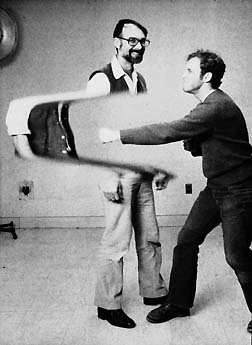Workshop Warping Time and Space:
Spatiotemporal Disruptive Imaging
By Maarten H. Lamers
Media Technology MSc program
Leiden University, Institute of Advanced Computer Science (LIACS)
A two-day workshop about spatiotemporal disruptive imaging, or warping time and space in images. Techniques are discussed through examples from arts and sciences. Students complete the workshop by creating their own time-space warped images.
In spatiotemporal images not all dimensions are purely spatial; some represent the passing of time.
The workshop aims to teach students understanding of the relations between time and space in images taken over time, and how this can disrupt our preconception of time-space. Possible techniques that can be used for creating spatiotemporally distorted images are discussed. Many examples and artworks are shown for each technique. Focus of discussion is on the spatiotemporal relations within the images, less on technical details.

Photo: spatiotemporal photograph by Andrew Davidhazy, one of the pioneers in this field (undated; photo source).
In spatiotemporal video, distances between subsequent frames can represent spatial displacement instead of time's passing.
Some hands-on experience with simple but suitable techniques is part of the workshop. Students are challenged to create their own space-time disrupting images by a technique of their choice. Among the techniques discussed are:
-
slitscan photography,
digital manipulation of time and space in video,
temporal aliasing (stroboscopic effects, slit stroboscopy),
time-slicing (a.k.a. "bullet time" from the movie The Matrix).
Workshop Details
The format is one full day (8 hours) consisting of lectures, discussions, demonstrations and hands-on experimenting. After this day, students work at home to create multiple spatiotemporally disrupted images, by a technique of their choice (approximately 16 hours work). On a dedicated half-day (4 hours) students return to present and discuss their results.
Students should bring their own laptop with Processing installed, and at least one webcam (preferably more). Some programming experience in the Processing language, or a comparable language, is required. No heavy programming skills required, though. If students happen to have a stroboscope, they are urged to bring it along.
Successful completion of the course is assessed by means of participation level in class and results of the assignment. Upon successful completion, 1 EC can be awarded.
References
Thousands of resources and interesting projects can be found online. Here is a short selection of links that I used for this workshop.
-
For links to many artworks discussed in class, visit Golan Levin's excellent An Informal Catalogue of Slit-Scan Video Artworks
Slit-Scan Photography, introduction level text by Andrew Davidhazy
Tim Macmillan's Time-Slice Films Ltd
A good explanation of Time Slicing by Scott Anderson
Some page about Morphovision, by Toshio Iwai
Homepage of the tx-transform